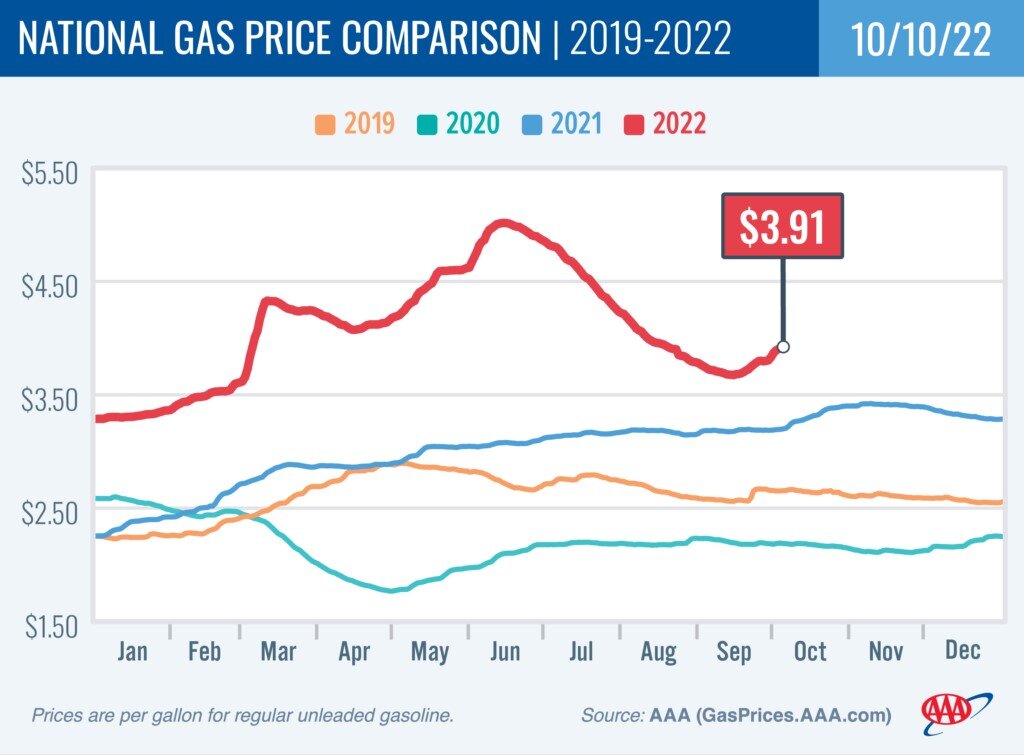Residential Real Estate News

Rising Oil Costs to Further Impact Future Holiday Travel Demand
Residential News » Los Angeles Edition | By Michael Gerrity | October 11, 2022 8:11 AM ET
AAA is reporting this week that price of oil creeping above $90 a barrel for the first time in several weeks, driven by OPEC+ recent announcement that the group of oil-producing nations would slash output by 2 million barrels per day.
A higher cost for oil usually means more expensive gasoline and higher travel costs for both consumers and business travelers. Meanwhile, domestic demand increased as more drivers fueled up last week. The national average pump price for a gallon of gas rose 12 cents over the past week to hit $3.91.
"Gas prices in California are finally cooling off, as more refineries come back online after undergoing maintenance and the switch to cheaper winter blends takes effect," said Andrew Gross, AAA spokesperson. "High West Coast prices have played a major role in the recent climb in the national average for gas. Reversing this trend may help take some pressure off of pump prices."
According to new data from the Energy Information Administration (EIA), gas demand increased nationally from 8.83 million b/d to 9.47 million b/d last week. Total domestic gasoline stocks decreased significantly by 4.7 million bbl to 207.5 million bbl. High gasoline demand, amid tight supply, has led to higher pump prices nationwide.
Today's national average of $3.91 is 19 cents higher than a month ago, and 65 cents more than a year ago.
U.S. Gas Price Increase Stats
The nation's top 10 largest weekly increases: Maryland (+24 cents), Delaware (+24 cents), Illinois (+24 cents), Ohio (+23 cents), Louisiana (+22 cents), Tennessee (+21 cents), Indiana (+21 cents), Alaska (+20 cents), Mississippi (+20 cents) and North Carolina (+20 cents).
The nation's top 10 most expensive markets: California ($6.33), Alaska ($5.54), Oregon ($5.53), Nevada ($5.44), Washington ($5.40), Hawaii ($5.21), Arizona ($4.56), Idaho ($4.42), Illinois ($4.40) and Michigan ($4.35).
Sign Up Free | The WPJ Weekly Newsletter
Relevant real estate news.
Actionable market intelligence.
Right to your inbox every week.
Real Estate Listings Showcase
Related News Stories
Residential Real Estate Headlines
- More Americans Opting for Renting Over Homeownership in 2024
- BLOCKTITLE Global Property Tokenization Platform Announced
- Small Investors Quietly Reshaping the U.S. Housing Market in Late 2024
- Greater Miami Overall Residential Sales Dip 9 Percent in November
- U.S. Home Sales Enjoy Largest Annual Increase in 3 Years Post Presidential Election
- U.S. Housing Industry Reacts to the Federal Reserve's Late 2024 Rate Cut
- U.S. Home Builders Express Optimism for 2025
- Older Americans More Likely to Buy Disaster-Prone Homes
- NAR's 10 Top U.S. Housing Markets for 2025 Revealed
- U.S. Mortgage Delinquencies Continue to Rise in September
- U.S. Mortgage Rates Tick Down in Early December
- Post Trump Election, U.S. Homebuyer Sentiment Hits 3-Year High in November
- Global Listings Aims to Become the Future 'Amazon of Real Estate' Shopping Platform
- Greater Las Vegas Home Sales Jump 15 Percent in November
- Ultra Luxury Home Sales Globally Experience Slowdown in Q3
- World Property Exchange Announces Development Plan
- Hong Kong Housing Market to Reach Equilibrium in Late 2025
- Construction Job Openings in U.S. Down 40 Percent Annually in October
- U.S. Mortgage Applications Increase in Late October
- World Property Markets, World Property Media to Commence Industry Joint-Venture Funding Rounds in 2025
- New Home Sales Hit 2 Year Low in America
- U.S. Pending Home Sales Increase for Third Consecutive Month in October
- Pandemic-led Residential Rent Boom is Now Fizzling in the U.S.
- Emerging Global Real Estate Streamer WPC TV Expands Video Programming Lineup
- 1 in 5 Renters in America Entire Paycheck Used to Pay Monthly Rent in 2024
- U.S. Home Sales Jump 3.4 Percent in October
- Home Buyers Negotiation Power Grows Amid Cooling U.S. Market
- Canadian Home Sales Surge in October, Reaching a Two-Year High
- Greater Orlando Area Home Sales Continue to Slide in October
- U.S. Mortgage Credit Availability Increased in October
- U.S. Mortgage Rates Remain Stubbornly High Post Election, Rate Cuts
- Construction Input Prices Continue to Rise in October
- BETTER MLS: A New Agent and Broker Owned National Listings Platform Announced
- Home Prices Rise in 87 Percent of U.S. Metros in Q3
- Caribbean Islands Enjoying a New Era of Luxury Property Developments
- The World's First 'Global Listings Service' Announced
- Agent Commission Rates Continue to Slip Post NAR Settlement
- Market Share of First Time Home Buyers Hit Historic Low in U.S.
- Greater Palm Beach Area Residential Sales Drop 20 Percent Annually in September
- Mortgage Applications in U.S. Dip in Late October






